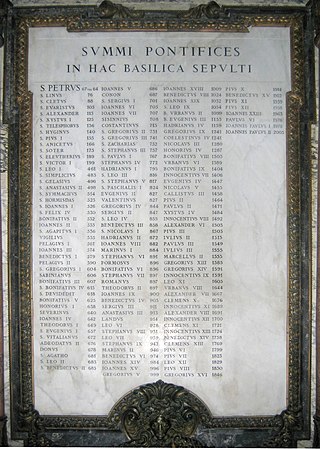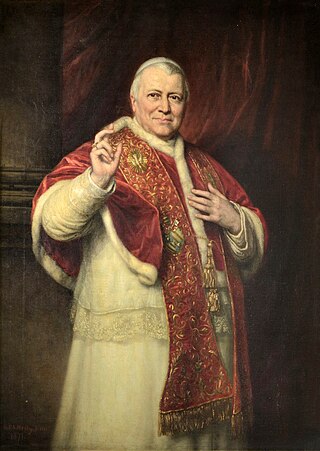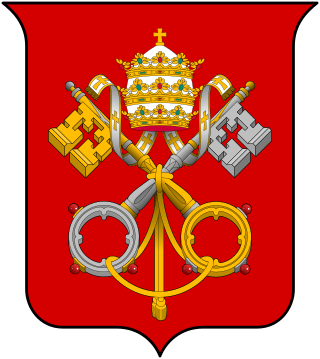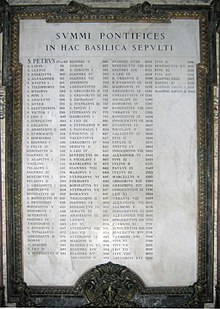
The Holy See, also called the See of Rome, Petrine See, Apostolic See, and Government of Vatican City, is the jurisdiction of the Pope in his role as the bishop of Rome and sovereign of Vatican City. It includes the apostolic episcopal see of the Diocese of Rome, which has ecclesiastical jurisdiction over the Catholic Church, and sovereignty and governance over the city-state known as Vatican City.

The pope, also known as the supreme pontiff, Roman pontiff or sovereign pontiff, is the bishop of Rome, head of the worldwide Catholic Church, and has also served as the head of state or sovereign of the Papal States and later the Vatican City State since the eighth century. From a Catholic viewpoint, the primacy of the bishop of Rome is largely derived from his role as the apostolic successor to Saint Peter, to whom primacy was conferred by Jesus, who gave Peter the Keys of Heaven and the powers of "binding and loosing", naming him as the "rock" upon which the Church would be built. The current pope is Francis, who was elected on 13 March 2013.

Pope John XXIII, was head of the Catholic Church and sovereign of the Vatican City State from 28 October 1958 until his death in June 1963. He was among 13 children born to Marianna Mazzola and Giovanni Battista Roncalli in a family of sharecroppers who lived in Sotto il Monte, a village in the province of Bergamo, Lombardy. He was ordained to the priesthood on 10 August 1904 and served in a number of posts, as nuncio in France and a delegate to Bulgaria, Greece and Turkey. In a consistory on 12 January 1953 Pope Pius XII made Roncalli a cardinal as the Cardinal-Priest of Santa Prisca in addition to naming him as the Patriarch of Venice. Roncalli was unexpectedly elected pope on 28 October 1958 at age 76 after eleven ballots. Pope John XXIII surprised those who expected him to be a caretaker pope by calling the historic Second Vatican Council (1962–1965), the first session opening on 11 October 1962.

Pope Benedict XIII, born Pietro Francesco Orsini and later called Vincenzo Maria Orsini, was head of the Catholic Church and ruler of the Papal States from 29 May 1724 to his death in February 1730.

Pope Paul VI was head of the Catholic Church and sovereign of the Vatican City State from 21 June 1963 to his death in August 1978. Succeeding John XXIII, he continued the Second Vatican Council, which he closed in 1965, implementing its numerous reforms. He fostered improved ecumenical relations with Eastern Orthodox and Protestant churches, which resulted in many historic meetings and agreements. In January 1964, he flew to the Hashemite Kingdom of Jordan. This was the first time a reigning pontiff had flown on an airplane, the first papal pilgrimage to the Holy Land, and the first time a Pope had left Italy in more than a century.
The politics of Vatican City take place in a framework of a theocratic absolute elective monarchy, in which the Pope, religiously speaking, the leader of the Catholic Church and Bishop of Rome, exercises ex officio supreme legislative, executive, and judicial power over the Vatican City as it is being governed by the Holy See, a rare case of non-hereditary monarchy.
A papal renunciation also called a papal abdication, occurs when the reigning pope of the Catholic Church voluntarily steps down from his position. As the reign of the pope has conventionally been from election until death, papal renunciation is an uncommon event. Before the 21st century, only five popes unambiguously resigned with historical certainty, all between the 10th and 15th centuries. Additionally, there are disputed claims of four popes having resigned, dating from the 3rd to the 11th centuries; a fifth disputed case may have involved an antipope.
The title His Holiness or Her Holiness is an official title or style referring to leaders in a number of religious traditions. It is used to refer to the pope in Catholicism; this use can be traced back several hundred years. It is also an official title for Oriental Orthodox patriarchs or Catholicoi. It is used to refer to religious leaders in Islam, Buddhism, and Bon. Buddhist leaders referred to this way include Lu Sheng-yen, the Dalai Lama, the Menri Trizin, and Da'i al-Mutlaq of the Dawoodi Bohras, among others.

The history of the papacy, the office held by the pope as head of the Catholic Church, spans from the time of Peter, to the present day. Moreover, many of the bishops of Rome in the first three centuries of the Christian era are obscure figures. Most of Peter's successors in the first three centuries following his life suffered martyrdom along with members of their flock in periods of persecution.

Papal supremacy is the doctrine of the Catholic Church that the Pope, by reason of his office as Vicar of Christ, the visible source and foundation of the unity both of the bishops and of the whole company of the faithful, and as pastor of the entire Catholic Church, has full, supreme, and universal power over the whole church, a power which he can always exercise unhindered: that, in brief, "the Pope enjoys, by divine institution, supreme, full, immediate, and universal power in the care of souls."

A papal name or pontificial name is the regnal name taken by a pope. Both the head of the Catholic Church, usually known as the pope, and the pope of the Coptic Orthodox Church of Alexandria choose papal names. As of 2013, Pope Francis is the Catholic pope, and Tawadros II or Theodoros II is the Coptic pope. This article discusses and lists the names of Catholic popes; another article has a list of Coptic Orthodox popes of Alexandria.

Vatican during the Savoyard era describes the relation of the Vatican to Italy, after 1870, which marked the end of the Papal States, and 1929, when the papacy regained autonomy in the Lateran Treaty, a period dominated by the Roman Question.

The Diocese of Rome, also called the Vicariate of Rome, is the ecclesiastical district under the direct jurisdiction of the Pope, who is Bishop of Rome and hence the supreme pontiff and head of the worldwide Catholic Church. As the Holy See, the papacy is a sovereign entity with diplomatic relations, and civil jurisdiction over the Vatican City State located geographically within Rome. The Diocese of Rome is the metropolitan diocese of the Province of Rome, an ecclesiastical province in Italy. The first bishop of Rome was Saint Peter in the first century. The incumbent since 13 March 2013 is Pope Francis.
The historical roots of Papal primacy can be traced back to the early centuries of Christianity, wherein the Bishop of Rome, commonly referred to as the Pope, gradually accrued increasing authority and recognition. A confluence of historical, theological, and political factors contributed to this development.

Pope John Paul II reigned as pope of the Roman Catholic Church and sovereign of the Vatican City State for 26 years from October 1978 to his death, on 2 April 2005. Since his death, many thousands of people have been supporting the case for beatifying and canonising Pope John Paul II as a saint. His formal beatification ceremony took place on 1 May 2011.

Peter of Candia, also known as Peter Phillarges, named as Alexander V, was an antipope elected by the Council of Pisa during the Western Schism (1378–1417). He reigned briefly from 26 June 1409, to his death in 1410, in opposition to the Roman pope Gregory XII and the Avignon antipope Benedict XIII. In the 20th century, the Catholic Church reinterpreted the Western Schism by recognising the Roman popes as legitimate. Gregory XII's reign was extended to 1415, and Alexander V is now regarded as an antipope.
The orders, decorations, and medals of the Holy See include titles, chivalric orders, distinctions and medals honoured by the Holy See, with the Pope as the fount of honour, for deeds and merits of their recipients to the benefit of the Holy See, the Catholic Church, or their respective communities, societies, nations and the world at large.

The titles of the bishop of Rome, more often referred to as papal titles refer to the various titles used by protocol, as a form of addressing or designating a theological or secular reality of the bishop of Rome (pope). The Catholic Church believes that they "constitute what has been termed a primacy of honor. These prerogatives are not, like his jurisdictional rights, tied to the divine jure of his office. They have grown in the course of history, and have been enshrined by the passage of centuries, but they are not free from modification."





















